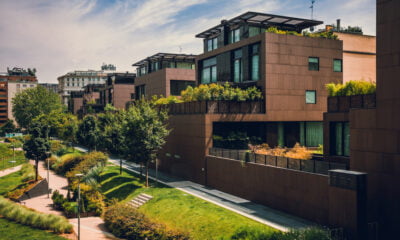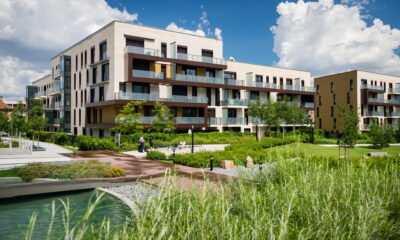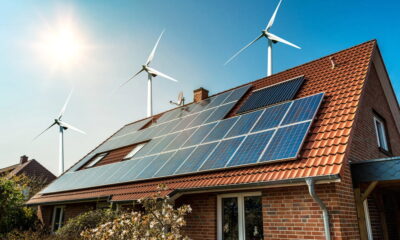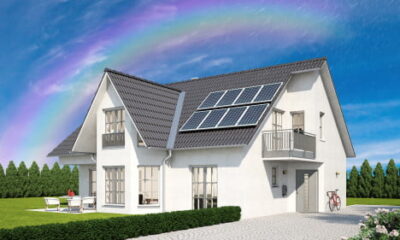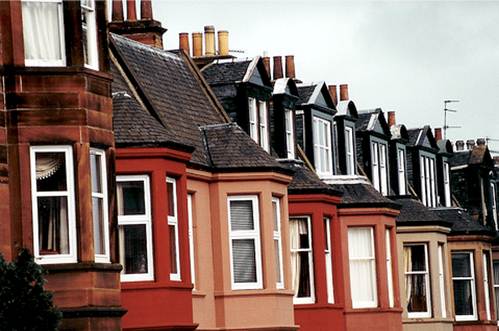

Features
Green homes: will patience pay?
Architect Luke Tozer takes a close look at the realities of sustainable housing.
Few people commission a home directly. Most houses are provided by builders, developers and registered social landlords (RSLs) who then sell or rent them to occupants.
People on Kevin McCloud’s Grand Designs programme are ahead of the curve and can usually afford to indulge their environmental preoccupations. Spending a few thousand pounds in upgraded insulation seems cheap when building from scratch, though investing far beyond the building regulations still takes longer to pay back than the average house stay of seven years.
The Feed-in Tariff’s introduction last April changed the market in renewables for householders. It’s now possible to get a decent rate of return, assuming you have the right conditions of orientation to take advantage of it. But it would be foolish to install such technologies without minimising the carbon footprint of the house in the first place.
The demonstration houses at the British Research Establishment innovation park outside Watford show how far you can go and how much you can spend to achieve an ambitious low-energy home on a one-off basis, but the general lessons are rather harder to extrapolate. The Coalition Government’s Green Deal, representing an attempt to move the market in retrofitting fabric improvements, will start coming on-stream in 2012. Intelligently the costs of the work stay with the house, even if the owner sells and moves, and are paid back through energy bills over time.
The Technology Strategy Board Retrofit for the Future projects should provide further evidence that can be applied more widely. Costs are likely to fall significantly through economies of scale.
House builders and developers generally seek the most cost-effective way of meeting planning and building regulations requirements. But without long-term interest being retained in the land, and with no demonstrable premium for a sustainable home, few house builders can afford to pursue sustainability aggressively.
Social landlords have motives other than pure profit and often need to address issues of corporate responsibility for themselves and fuel poverty for their tenants. After all, building a home that needs no heating means even the poorest can afford to live there.
Registered social landlords and local authorities often have large housing stocks with long-term tenants, and undertaking refurbishment works with people in situ presents real challenges. Effective communication and tenant liaison, coupled with simple straightforward controls, are critical for the ongoing success of any sustainable scheme. A household’s carbon footprint is dramatically affected by its occupants’ lifestyle choices, as well as by the fabric of the house. Research suggests that two neighbouring low energy households can have a threefold difference in carbon footprint, so helping occupants understand how best to use buildings and make low energy choices is vital.
The key to pursuing sustainability is long-term interest in what’s being built. If you’re a private developer needing to sell quickly to recoup your investment, it’s simply not economically feasible to pursue sustainability beyond the minimum demanded by planning and building regulations. A wider take-up of sustainable housing can happen only when long-term planning for sustainability also pays dividends in the shorter term, or when real financial benefits accrue from retaining a long-term interest in the land.
Going beyond current requirements
Le Corbusier named a house “a machine for living in” in 1923 but today it might be more accurately called “a machine for living in sustainably”. By 2016 all new homes in the UK are due to be zero carbon, with incremental carbon footprint reductions for the trickier existing building stock leading to an 80 percent reduction by 2050. Legislation changes force behavioural changes, so the main tool for achieving these is in the building regulations, with stepped improvements along the way.
Yet people are building sustainable houses that go beyond current requirements – why? For homeowners and institutional investors the reasons differ, but for both it’s as a result of longer-term thinking rather than a quick return on investment.
Even now the cost benefit of reducing the environmental impact of a home is difficult to value except by anticipated reductions to energy bills. The energy performance certificate helped, but few estate agents regard a good score as a major selling point, as the lack of empirical evidence makes it hard for a purchaser to factor it into their criteria. Location and size come first, with energy performance, if not quite last, very low down the list. Clearly this could change if energy costs continue to rise, but for now if you’re building a sustainable house it’s usually for reasons that are not immediately financial.
Some of the more patient developers and long-term investors, such as Grosvenor Estates, have starting building high-value, low-energy apartments. These will test whether there is, or could be, a premium for low-energy housing in the way there has started to be in commercial buildings. Still, it’s early days.


 Environment10 months ago
Environment10 months agoAre Polymer Banknotes: an Eco-Friendly Trend or a Groundswell?

 Environment11 months ago
Environment11 months agoEco-Friendly Home Improvements: Top 7 Upgrades for 2025

 Features9 months ago
Features9 months agoEco-Friendly Cryptocurrencies: Sustainable Investment Choices

 Features10 months ago
Features10 months agoEco-Friendly Crypto Traders Must Find the Right Exchange
